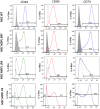When do the pathological signs become evident? Study of human mesenchymal stem cells in MDPL syndrome
- PMID: 39611849
- PMCID: PMC11723661
- DOI: 10.18632/aging.206159
When do the pathological signs become evident? Study of human mesenchymal stem cells in MDPL syndrome
Abstract
Aging syndromes are rare genetic disorders sharing the features of accelerated senescence. Among these, Mandibular hypoplasia, Deafness and Progeroid features with concomitant Lipodystrophy (MDPL; OMIM #615381) is a rare autosomal dominant disease due to a de novo in-frame deletion in POLD1 gene, encoding the catalytic subunit of DNA polymerase delta. Here, we investigated how MSCs may contribute to the phenotypes and progression of premature aging syndromes such as MDPL. In human induced pluripotent stem cells (hiPSCs)-derived MSCs of three MDPL patients we detected several hallmarks of senescence, including (i) abnormal nuclear morphology, (ii) micronuclei presence, (iii) slow cell proliferation and cell cycle progression, (iv) reduced telomere length, and (v) increased levels of mitochondrial reactive oxygen species (ROS). We newly demonstrated that the pathological hallmarks of senescence manifest at an early stage of human development and represent a warning sign for the progression of the disease. Dissecting the mechanisms underlying stem cell dysfunction during aging can thereby contribute to the development of timely pharmacological therapies for ameliorating the pathological phenotype.
Keywords: MDPL syndrome; MSCs; POLD1 gene; aging; hiPSCs.
Conflict of interest statement
Figures








References
-
- Weedon MN, Ellard S, Prindle MJ, Caswell R, Lango Allen H, Oram R, Godbole K, Yajnik CS, Sbraccia P, Novelli G, Turnpenny P, McCann E, Goh KJ, et al.. An in-frame deletion at the polymerase active site of POLD1 causes a multisystem disorder with lipodystrophy. Nat Genet. 2013; 45:947–50. 10.1038/ng.2670 - DOI - PMC - PubMed
-
- Shastry S, Simha V, Godbole K, Sbraccia P, Melancon S, Yajnik CS, Novelli G, Kroiss M, Garg A. A novel syndrome of mandibular hypoplasia, deafness, and progeroid features associated with lipodystrophy, undescended testes, and male hypogonadism. J Clin Endocrinol Metab. 2010; 95:E192–7. 10.1210/jc.2010-0419 - DOI - PMC - PubMed
-
- Novelli G, Muchir A, Sangiuolo F, Helbling-Leclerc A, D'Apice MR, Massart C, Capon F, Sbraccia P, Federici M, Lauro R, Tudisco C, Pallotta R, Scarano G, et al.. Mandibuloacral dysplasia is caused by a mutation in LMNA-encoding lamin A/C. Am J Hum Genet. 2002; 71:426–31. 10.1086/341908 - DOI - PMC - PubMed
MeSH terms
Substances
LinkOut - more resources
Full Text Sources

